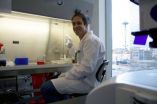The team, co-led by Stephen Tapscott, M.D., Ph.D., a member of the Hutchinson Center's Human Biology Division, discovered that a rare variant of FSHD, called type 2, which accounts for about 5 percent of cases, is caused by two genetic mutations that together cause the production of muscle-damaging toxins responsible for causing symptoms of this progressive muscle disease.
Specifically, the researchers found that a combination of genetic variants on chromosomes 4 (called DUX4) and 18 (called SMCHD1) can cause type 2 FSHD. The DUX4 variant was first described by the research team in 2010 as a mechanism behind the more common, type 1, version of the disease.
"Many diseases caused by a single gene mutation have been identified during the last several decades, but it has been more difficult to identify the genetic basis of diseases that are caused by the intersection of multiple genetic flaws," Tapscott said. "Recent advances in DNA sequencing made this study possible and it is likely that other diseases caused by the inheritance of multiple genetic variants will be identified in the coming years."
Understanding the genetic mechanisms of type 2 FSHD could lead to new biomarker-based tests for diagnosing the disease and could lead to the development of future treatments, Tapscott said.
FSHD affects about half a million people worldwide. Symptoms usually first appear around age 20 and are characterized by a progressive, gradual loss of muscle strength, particularly in the upper body.
###
In addition to Tapscott and other Hutchinson Center researchers, other key members of the research team included Daniel G. Miller, M.D., Ph.D., an associate professor of pediatrics at the University of Washington; Rabi N. Tawil, M.D., a professor of neurology at the University of Rochester Medical Center; and Silvère van der Maarel, Ph.D., a professor of medical epigenetics at Leiden University Medical Center in The Netherlands; plus investigators from Raboud University Nijmegen Medical Centre in The Netherlands and Nice University Hospital in France.
Funding for the research came from multiple institutions at the National Institutes of Health (National Institute of Neurological Disorders and Stroke, Clinical and Translational Science Awards Program, National Institute of Arthritis and Musculoskeletal and Skin Diseases, National Human Genome Research Institute and the National Genetics Institute), Friends of FSH Research, the Muscular Dystrophy Association, and the University of Rochester Medical Center Fields Center for FSHD and Neuromuscular Research.
At Fred Hutchinson Cancer Research Center, home to three Nobel laureates, interdisciplinary teams of world-renowned scientists seek new and innovative ways to prevent, diagnose and treat cancer, HIV/AIDS and other life-threatening diseases. The Hutchinson Center's pioneering work in bone marrow transplantation led to the development of immunotherapy, which harnesses the power of the immune system to treat cancer with minimal side effects. An independent, nonprofit research institute based in Seattle, the Hutchinson Center houses the nation's first and largest cancer prevention research program, as well as the clinical coordinating center of the Women's Health Initiative and the international headquarters of the HIV Vaccine Trials Network. Private contributions are essential for enabling Hutchinson Center scientists to explore novel research opportunities that lead to important medical breakthroughs. For more information visit www.fhcrc.org or follow the Hutchinson Center on Facebook, Twitter or YouTube.
Researchers discover 2 genetic flaws behind common form of inherited muscular dystrophy
Latest in a series of groundbreaking discoveries
2012-11-12
(Press-News.org) SEATTLE – An international research team co-led by a scientist at Fred Hutchinson Cancer Research Center has identified two genetic factors behind the third most common form of muscular dystrophy. The findings, published online in Nature Genetics, represent the latest in the team's series of groundbreaking discoveries begun in 2010 regarding the genetic causes of facioscapulohumeral muscular dystrophy, or FSHD.
ELSE PRESS RELEASES FROM THIS DATE:
Touch-sensitive plastic skin heals itself
2012-11-12
Nobody knows the remarkable properties of human skin like the researchers struggling to emulate it. Not only is our skin sensitive, sending the brain precise information about pressure and temperature, but it also heals efficiently to preserve a protective barrier against the world. Combining these two features in a single synthetic material presented an exciting challenge for Stanford Chemical Engineering Professor Zhenan Bao and her team.
Now, they have succeeded in making the first material that can both sense subtle pressure and heal itself when torn or cut. Their ...
36 in one fell swoop -- researchers observe 'impossible' ionization
2012-11-12
This press release is available in German.
Using the world's most powerful X-ray laser in California, an international research team discovered a surprising behaviour of atoms: with a single X-ray flash, the group led by Daniel Rolles from the Center for Free-Electron Laser Science (CFEL) in Hamburg (Germany) was able to kick a record number of 36 electrons at once out of a xenon atom. According to theoretical calculations, these are significantly more than should be possible at this energy of the X-ray radiation. The team present their unexpected observations in the ...
'Groundwater inundation' doubles previous predictions of flooding with future sea level rise
2012-11-12
Scientists from the University of Hawaii at Manoa (UHM) published a study today in Nature Climate Change showing that besides marine inundation (flooding), low-lying coastal areas may also be vulnerable to "groundwater inundation," a factor largely unrecognized in earlier predictions on the effects of sea level rise (SLR). Previous research has predicted that by the end of the century, sea level may rise 1 meter. Kolja Rotzoll, Postdoctoral Researcher at the UHM Water Resources Research Center and Charles Fletcher, UHM Associate Dean, found that the flooded area in urban ...
Game changer for arthritis and anti-fibrosis drugs
2012-11-12
(SALT LAKE CITY)—In a discovery that can fundamentally change how drugs for arthritis, and potentially many other diseases, are made, University of Utah medical researchers have identified a way to treat inflammation while potentially minimizing a serious side effect of current medications: the increased risk for infection.
These findings provide a new roadmap for making powerful anti-inflammatory medicines that will be safer not only for arthritis patients but also for millions of others with inflammation-associated diseases, such as diabetes, traumatic brain injury, ...
CSHL-led team discovers new way in which plants control flower production
2012-11-12
Cold Spring Harbor, N.Y. – Flowers don't just catch our eyes, they catch those of pollinators like bees as well. They have to, in order to reproduce. Because plants need to maximize the opportunity for pollinators to gain access to their seeds, variations in the timing of flowering can have profound effects on flower, fruit, and seed production, and consequently agricultural yields.
We know that the major driving forces of flowering are external factors such as light and temperature. However, new research from CSHL Assistant Professor Zach Lippman, Ph.D. and his collaborators, ...
Mutations in genes that modify DNA packaging result in Facioscapulohumeral Muscular Dystrophy
2012-11-12
A recent finding by medical geneticists sheds new light on how Facioscapulohumeral Muscular Dystrophy develops and how it might be treated. More commonly known as FSHD, the devastating disease affects both men and women.
FSHD is usually an inherited genetic disorder, yet sometimes appears spontaneously via new mutations in individuals with no family history of the condition.
"People with the condition experience progressive muscle weakness and about 1 in 5 require wheelchair assistance by age 40," said Dr. Daniel G. Miller, University of Washington associate professor ...
Study provides recipe for 'supercharging' atoms with X-ray laser
2012-11-12
Researchers using the Linac Coherent Light Source (LCLS) at the U.S. Department of Energy's (DOE) SLAC National Accelerator Laboratory have found a way to strip most of the electrons from xenon atoms, creating a "supercharged," strongly positive state at energies previously thought too low.
The findings, which defy expectations and theory, could help scientists deliberately induce the high levels of damage needed to study extreme states of matter or ward off damage in samples they're trying to image. The results were reported this week in Nature Photonics.
While the ...
Why Antarctic sea ice cover has increased under the effects of climate change
2012-11-12
The first direct evidence that marked changes to Antarctic sea ice drift have occurred over the last 20 years, in response to changing winds, is published this week in the journal Nature Geoscience. Scientists from NERC's British Antarctic Survey (BAS) and NASA's Jet Propulsion Laboratory (JPL), Pasadena California explain why, unlike the dramatic losses reported in the Arctic, the Antarctic sea ice cover has increased under the effects of climate change.
Maps created by JPL using over 5 million individual daily ice motion measurements captured over a period of 19 years ...
Did wild birds cause the 2010 deadly West Nile virus outbreak in Greece?
2012-11-12
In 2010, 35 people in Greece died from a West Nile virus (WNV) outbreak, with a further 262 laboratory-confirmed human cases. A new article published in BioMedCentral's open access journal Virology Journal examines whether wild or migratory birds could have been responsible for importing and amplifying the deadly virus.
WNV is a flavivirus of major public health concern, spread through the bite of infected mosquitoes. Discovered in Uganda in 1937, it was only sporadically reported up until the 1990s, after which disease outbreaks were reported world-over, leading to ...
Scientists discover new method of gene identification
2012-11-12
Scientists studying the genes and proteins of human cells infected with a common cold virus have identified a new gene identification technique that could increase the genetic information we hold on animals by around 70 to 80 per cent. The findings, published in Nature Methods, could revolutionise our understanding of animal genetics and disease, and improve our knowledge of dangerous viruses such as SARS that jump the species barrier from animals to humans.
Modern advances in genome sequencing — the process of determining the genetic information and variation controlling ...
LAST 30 PRESS RELEASES:
University of Oklahoma researcher awarded funding to pursue AI-powered material design
Exploring how the visual system recovers following injury
Support for parents with infants at pediatric check-ups leads to better reading and math skills in elementary school
Kids’ behavioral health is a growing share of family health costs
Day & night: Cancer disrupts the brain’s natural rhythm
COVID-19 vaccination significantly reduces risk to pregnant women and baby
The role of vaccination in maternal and perinatal outcomes associated with COVID-19 in pregnancy
Mayo Clinic smartwatch system helps parents shorten and defuse children's severe tantrums early
Behavioral health spending spikes to 40% of all children’s health expenditures, nearly doubling in a decade
Digital cognitive behavioral treatment for generalized anxiety disorder
Expenditures for pediatric behavioral health care over time and estimated family financial burden
Air conditioning in nursing homes and mortality during extreme heat
The Alps to lose a record number of glaciers in the next decade
What makes a good proton conductor?
New science reporting guide published for journalists in Bulgaria
New international study reveals major survival gaps among children with cancer
New science reporting guide published for journalists in Turkey
Scientists develop a smarter mRNA therapy that knows which cells to target
Neuroanatomy-informed brain–machine hybrid intelligence for robust acoustic target detection
Eight SwRI hydrogen projects funded by ENERGYWERX
The Lundquist Institute and its start-up company Vitalex Biosciences Announces Strategic Advancement of Second-Generation fungal Vaccine VXV-01 through Phase 1 Trials under $40 Million Competitive Con
Fine particles in pollution are associated with early signs of autoimmune disease
Review article | Towards a Global Ground-Based Earth Observatory (GGBEO): Leveraging existing systems and networks
Penn and UMich create world’s smallest programmable, autonomous robots
Cleveland researchers launch first major study to address ‘hidden performance killer’ in athletes
To connect across politics, try saying what you oppose
Modulating key interaction prevents virus from entering cells
Project explores barriers to NHS career progression facing international medical graduates
Jeonbuk National University researchers explore the impact of different seasonings on the flavor perception of Doenjang soup
Two Keck Medicine of USC Hospitals named Leapfrog Top Teaching Hospitals
[Press-News.org] Researchers discover 2 genetic flaws behind common form of inherited muscular dystrophyLatest in a series of groundbreaking discoveries



